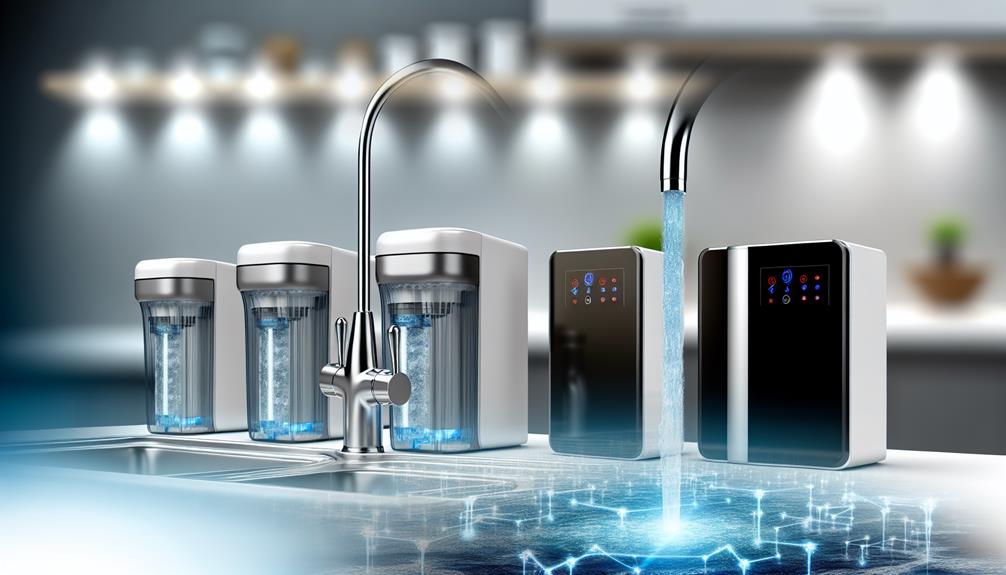Did you know that almost 2.2 billion people worldwide lack access to safely managed drinking water?
As you ponder over this startling fact, consider the role sustainable water filtering innovations have played in addressing this pressing issue.
Over the years, you've witnessed a remarkable transformation in how water is purified, from rudimentary sand and gravel filters to sophisticated membrane technologies that now promise potable water even from the most contaminated sources.
Each leap forward reflects humanity's persistent quest for cleaner and more accessible water.
As we look closer at these advancements, you'll uncover not only the ingenuity that spurred these changes but also the pressing challenges that remain unsolved, hinting at the continuous innovation that the future inevitably demands.
Early Filtration Methods Reimagined
Innovative techniques are revitalizing traditional water filtration methods, enhancing their efficiency and expanding their applicability to modern environmental challenges. Early Civilizations laid the groundwork for water treatment processes, utilizing rudimentary forms of sand filtration to improve water quality. Today, these age-old practices are being reimagined; 'Super Sand' emerges as a contemporary iteration, accelerating the filtration rate while maintaining the simplicity of the rapid sand filtration system.
Ceramic Water Filters, which date back to the famous Greek inventor Henry Doulton's 19th-century design, are now being optimized for modern use. These domestic water filters still rely on the micro-porous nature of clay, but with silver infusions, their bactericidal capabilities are significantly enhanced. However, they aren't without limitations; they don't remove arsenic, prompting the need for additional innovations.
To address this, a cost-effective method to remove arsenic using plastic bottles filled with iron oxide-coated sand has been devised. This approach pays homage to the use of alum by ancient civilizations to clarify water but leverages modern materials for targeted contaminant removal. Through such refinements, historical water purification practices are being transformed to meet the dual demands of efficacy and sustainability in contemporary water treatment.
Membrane Technology Breakthroughs
Membrane technology, with its precise filtration capabilities, is revolutionizing the approach to desalination and water purification. Innovative water purification has been immensely advanced through membrane technology breakthroughs. These innovations have enhanced the efficiency and reliability of water filtration systems, providing high-quality filtered water essential for both human consumption and industrial use.
Research and Development in this field has yielded significant improvements, particularly in the treatment processes involving the removal of Dissolved Solids. For instance, Direct-Contact Membrane Desalination, a prominent development, leverages plastic membranes to selectively filter out salt, drastically increasing potable water yield.
Key breakthroughs in membrane technology include:
- Direct-Contact Membrane Desalination: Achieves high conversion rates of seawater to drinking water using thermal energy.
- Ceramic Water Filters: Utilize micro-porous structure for biological contaminant removal, aiding in disease prevention.
- Herbal Defluoridation: Employs plant-based absorption techniques to tackle fluoride contamination in water sources.
Such advancements are integral to the revolution in water treatment, equipping water treatment plants to tackle diverse challenges. Moreover, the intersection of membrane technology with renewable energy sources, such as Solar Water heating systems, underscores the potential for sustainable and energy-efficient water treatment solutions.
Activated Carbon Redefined
Building on the strides made in membrane technology, 'Activated Carbon Redefined' marks the next step forward in water purification, enhancing traditional filtration methods with advanced activated carbon techniques to better tackle impurities. This novel approach aims to optimize the adsorption properties of activated carbon, allowing it to more effectively purify water contaminated with organic compounds, chemicals, and even microorganisms.
Your new system to remove contaminants not only targets common pollutants but also addresses emerging threats such as algal toxins and excessive fluoride, which are often found in water sources contaminated with raw sewage. By incorporating specialized modifications, 'Activated Carbon Redefined' increases the surface area and porosity of the carbon materials, bolstering their ability to capture and eliminate these hazardous substances.
Furthermore, the innovation introduces a symbiotic relationship between activated carbon and algae-killer bacteria. This pairing systematically eradicates algae, preventing the release of toxins and the risk of drinking contaminated water. Additionally, the reengineered carbon structure is now more adept at filtering out small objects, contributing to a comprehensive purification process.
As the world strives for greater access to clean water, 'Activated Carbon Redefined' presents a promising solution, ensuring safer drinking water through cutting-edge filtration technology.
Biological Water Purification Advances
Harnessing nature's own mechanisms, biological water purification advancements offer cost-effective and environmentally friendly solutions for removing pathogens and pollutants from water resources. You'll find that ceramic water filters have been pivotal in addressing waterborne diseases, such as cholera and typhoid, in developing countries. The incorporation of tiny porous clay coated with silver effectively targets biological contaminants like E.coli, which can cause severe gastrointestinal illnesses.
- Ceramic Water Filters: Reduce diarrheal disease and remove organisms like giardia and cryptosporidium.
- Herbal Water Purification: Attracts fluoride ions, offering a natural method for managing fluoride levels in water.
- 'Super Sand': Aids in the historical reduction of cholera through improved water flow and filtration.
However, these ceramic filters don't remove all harmful chemicals, for instance, arsenic. Meanwhile, the use of iron oxide-coated sand in plastic bottles presents an innovative yet simple approach to arsenic removal, crucial for areas plagued by contamination.
Portable water purification devices like the SteriPEN have also emerged, utilizing UV light to destroy pathogens and improve the safety of drinking water without leaving bad tastes. These devices are particularly useful for travelers and in emergency situations, where suspended sediment and other contaminants need to be addressed swiftly.
Modern Desalination Innovations
How does Direct-Contact Membrane Desalination present a breakthrough in the quest for sustainable water sources?
Developed by Kamalesh Sirkar, this innovation leverages a plastic membrane with minuscule pores to efficiently separate salt from seawater. It boasts an impressive conversion rate, where 80 liters of potable water are derived from 100 liters of seawater.
This process necessitates a consistent heat source, which ingeniously can be recycled from waste heat generated by industrial activities or oil drilling. Notably, this could be a game-changer for countries like Oman, where access to fresh water is paramount and such industrial operations are prevalent.
Sirkar's direct-contact methodology signifies a leap in desalination technology, moving away from more complex and energy-intensive distillation processes. The United States, among other nations, has come a long way in adopting and optimizing desalination techniques.
Pearce said that the simplicity and potential to utilize waste heat makes this approach particularly appealing, offering a sustainable and scalable solution to address global water scarcity. The speed at which this technology can be implemented could drastically improve water access, signaling a pivotal moment in the evolution of water filtering innovations.

